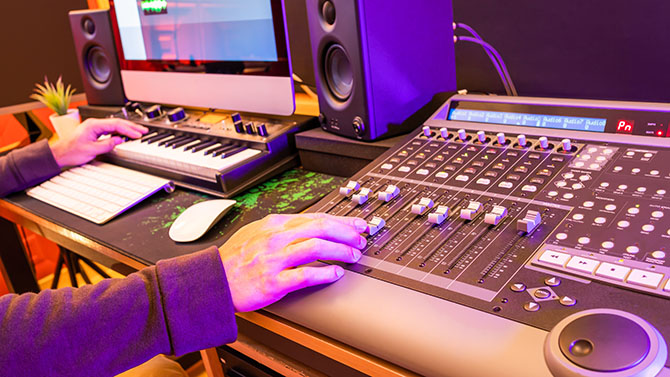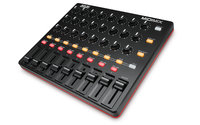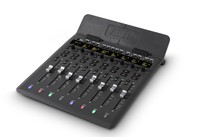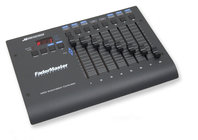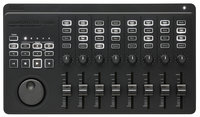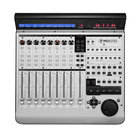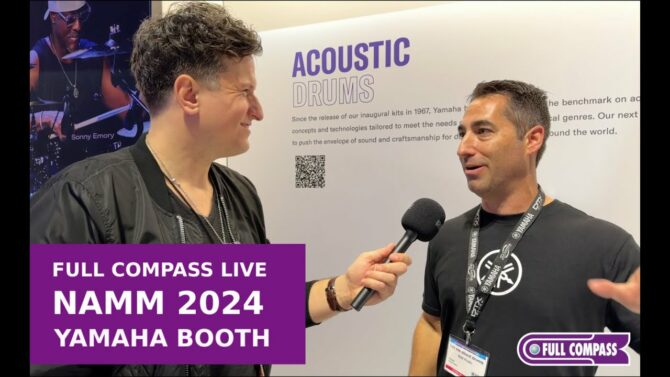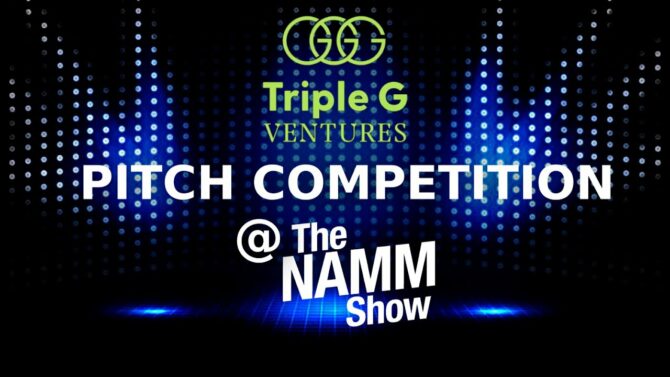In today’s virtual world, it’s easy to get nostalgic for the tactile feel of faders, knobs, and switches because analog Definition:
Definition:
A signal that is continuous in nature, as opposed to being defined as a series of discrete numbers (or elements) as found in digital signals; electrically "analogous" to an acoustical signal in the air. devices brought every function out to a physical control. Fortunately, we now have ways to restore some of that tactile feel to virtual mixers, software synthesizers, plug-in Definition:
Definition:
A software module, typically for signal processing or analysis, that inserts into the signal path of a DAW or video editor, or in some digital consoles. Also Plugin. effects, and more. Control surfaces are hardware-based remote controls for other equipment. They’re relevant for controlling software, which doesn’t offer hardware control. In this guide, we’ll focus on control surfaces for audio mixing.
However, controllers for MIDI Definition:
Definition:
(Musical Instrument Digital Interface) A hardware/software standard for communication of musical data digitally among electronic instruments, effects, and computers. However it is also used for to control lighting, pyrotechnics, theatrical displays, and mechanical devices. For example, the fountains at the Bellagio in Las Vegas is controlled by MIDI. Also called MIDI 1.0., lighting, video editing, and DJ Definition:
Definition:
DJ (Disk Jockey): 1. Traditionally applied to people who played recorded music on the radio or at events. 2. Artists who perform using any combination of pre-recorded music, samples, turntables, and musical instruments. work also exist. Some are multipurpose, such as those for music production that may combine mixing, recording, and instrument control. Mixer Definition:
Definition:
Combiner, controller, and router for multiple audio or video signals. control surfaces look like a mixing console Definition:
Definition:
A control surface for audio, video, or lighting control positioned like a desk. Also called, Mixer, Controller, Board, or (British) Desk. but generally don’t involve audio. They send digital Definition:
Definition:
A signal or data expressed as series of the digits 0 and 1, typically represented by values of a physical quantity such as voltage or magnetic polarization. control signals to the virtual mixers in DAWs (Digital Audio Workstations). However, some control surfaces also incorporate audio interface Definition:
Definition:
A device to convert audio signals into digital code suitable for use by a computer; typically communication occurs through a port such as USB, Thunderbolt, FireWire, etc. functionality.
The Origin Story
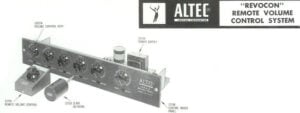
The history of mixing control surfaces began in the 1950s with Altec’s Revocon remote mixing controller Definition:
Definition:
1. A MIDI device (keyboard, guitar with appropriate interface, etc.) that alters parameters in a synthesizer or other MIDI sound generator. 2. A device (e.g., modulation wheel, pitch bender, ribbon controller, etc.) that varies some specific parameter in a synthesizer or other MIDI sound generator. for sound reinforcement Definition:
Definition:
Originally meant to electrically augment acoustic performances, but now means any public address system. See PA. (Fig. 1). It allowed an engineer to sit in the audience and control a backstage Definition:
Definition:
An area not open to the public where preparations for a performance take place, typically located behind the stage. or booth Definition:
Definition:
Control Room. Drum or vocal room in a studio. mixer with motorized controls on the mixer. In the 1960s, Fairchild introduced the Integra series of console mixers (Fig. 2). These included contemporary-looking channel strips that controlled a rack Definition:
Definition:
A frame for holding gear that meets an industry standard for enclosures. This specifies a 19 inch width, and a height that is some multiple of 1.75 inches. A rack frame can be open or enclosed, and has rails drilled with standardized screw holes for attaching rack equipment. mixer using LDR Definition:
Definition:
LDR (Light Dependent Resistor): A resistive element whose resistance varies according to the light shining on it. Used in some classic compressors to control levels. (light-dependent resistors) and reed relays.
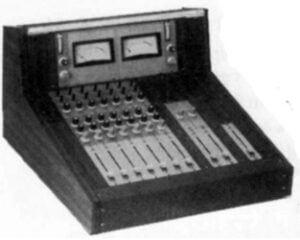
There wasn’t much further development until the later 1970s when motorized faders (flying faders) were invented. These allowed building mix automation Definition:
Definition:
With recording, the process of storing control and switch mixer moves so that they can be duplicated upon playback. capabilities into consoles because the position of physical faders could correlate to automation data Definition:
Definition:
Information used by a computer in order to arrive at a decision. Although this is a plural term, it's often treated in the singular.. For example, if the automation data created a fadeout, the fader Definition:
Definition:
An audio control, rotary or linear, to control volume level. would move from its current position down to 0 over the time specified by the automation. One of the first such systems was the Neve Necam. Although initially expensive, these products improved through the 1980s, and lower costs made them more commonplace. Digital recording has been around since the 70s but was primarily done on digital tape until hard disks became more cost-effective and computers became fast enough for real-time audio work. The earliest digital audio recorders did not mix but recording and mixing became practical on computers as processing power increased.
One of the first successful DAWs, Pro Tools, remains popular to this day. Editing and mixing moves can still be made with a keyboard and mouse, but most people prefer the intuitive, tactile nature of knobs, sliders, and buttons that control surfaces offer. Like digital mixers, they have a limited number of physical controls representing any number of channels or functions. For example, a control surface Definition:
Definition:
A device that provides mechanical controls, such as switches, rotary controls, and faders to provide hands-on control of software parameters. A typical application is creating a box with faders to control the levels in a software mixer. may have only eight motorized faders, but they can control any of several eight-channel Definition:
Definition:
1. In radio, television, citizen's band radio, and other wireless communications modes, a specific frequency for communication. 2. In mixers and video, an input or output signal path with controls. 3. In MIDI, one of 16 data paths. banks (channels 1-8, 9-16, 17-24, etc.) depending upon how assignments are made in the interface Definition:
Definition:
A device that adds I/O capability to another device. Common would be a MIDI, audio or video interface for a computer.. The motorized faders, display screens, knobs, and lit buttons reflect pre-programmed settings as a project progresses along a timeline. Control surfaces are also used for live mixing, where the mix engine may be located elsewhere and is connected to the control surface via a snake Definition:
Definition:
A cable with multiple internal cables in a common jacket. or networked connection. Furthermore, many digital mixers can also serve double-duty as universal controllers for other hardware such as signal processors or synthesizers and as control surfaces with audio interfacing capabilities for DAWs. Some controllers are designed for tight, proprietary compatibility with specific hardware or program applications. Others have universal protocols that are compatible Definition:
Definition:
Capable of operating with a particular selection of hardware or software. with a variety of brands. The connection between the controller and device is most often through either MIDI, Ethernet Definition:
Definition:
A local area network (LAN) using cables classified according to certain categories (CAT5, CAT6, CAT5e, etc.). These relate to the speed a cable can handle., or USB Definition:
Definition:
(Universal Serial Bus) A standard, bi-directional serial connection between computers and peripheral devices., although some offer wireless control. Today’s controllers cover a wide range of options. They can be simple, inexpensive boxes with a fader, knob, and a few assignable buttons for different DAW Definition:
Definition:
(Digital Audio Workstation): A computer program or stand-alone device that provides digital audio recording, editing, and mixing. functions, or complex providing control found in a typical hardware recording console.
Compatibility
Control surfaces manufactured by the same company that makes associated software programs will always offer the tightest integration and smoothest workflow. However, that doesn’t rule out using different controllers, which may have compatibility modes for use with various programs. The integration may not be as streamlined, but it will still do what’s required. In any case, before even thinking about which controller would be best for a particular production environment, it’s crucial to find out which controllers are supported by the software application. Here are the most common protocols.
- MCU (Mackie Control Universal): This common protocol offers the most support for a variety of DAWs and uses USB. Many proprietary hardware controllers also include an MCU mode for wider compatibility.
- HUI (Human User Interface): HUI is a subset of the MCU protocol, was developed by Mackie and DigiDesign (now Avid). Many hardware controllers include HUI as well as MCU compatibility.
- EuCon is an Ethernet-only, low-latency
 Definition:
Definition:
The amount of delay a signal, data, sound, video, or control signal acquires within a device, system, or long-distance connection. protocol developed by Euphonix. It offers deep integration and high performance, but it’s supported by fewer applications than MCU. - Diginet is a legacy protocol that’s not used in new products but was used for early versions of Pro Tools.
- DMX512: Although used primarily for performance lighting control, DMX512 can automate anything and is included in some control surfaces used for multi-media and performance.
- Smartphone and Tablet apps: Generally, these are proprietary for specific programs and hardware mixers. For example, PreSonus offers iOS
 Definition:
Definition:
Apple proprietary operating system, primarily for mobile devices (iPhone, iPad, iPod Touch, Apple Watch). Current Apple TVs run on tvOS, which is similar to, and based on, iOS. and Android apps that control Studio One and their mixers, but not products from other companies. Some apps, like TouchDAW and TouchOSC, are more general-purpose. - Wireless apps for mixer hardware are used to control a sound system’s mixer while ringing
 Definition:
Definition:
1. Sound system feedback that is not increasing into a continuous tone, but is nonetheless annoying. 2. A tone that can occur in the ear after exposure to excessively loud levels. With severe tinnitus, this tone can be continuous, or at least long-term. out sound in a venue. The operator can adjust the mix using functions like equalization as they walk around the venue. Remember that both app and program support can be a moving target because operating systems and features change over time.
Types of Controls on Control Surfaces
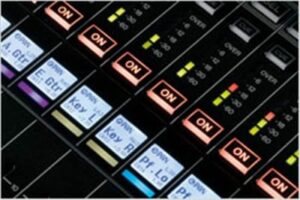
- Non-Motorized Faders These are conventional slider-style level controls. They work well for live production, music creation, DJ work, and looping
 Definition:
Definition:
1. (sampling) Repeating a section of a waveform so that it can sustain indefinitely. 2. (audio) The process of repeating a phrase or section of sound within a composition or recording. 3. (video) See: ADR. applications but aren’t recommended for mixing with DAWs. - Motorized Faders These faders are motorized so they can represent the physical position of a channel’s level at a specific position in a mix’s timeline. Grabbing the fader overrides the previous setting, and records new automation data.
- Infinite Rotary Encoders are knobs without minimum and maximum stop points. They edit panning, aux mix sends, effects parameters, and adjustable parameters. They may be surrounded by a ring of LED
 Definition:
Definition:
LED (Light-Emitting Diode): A semiconductor light generator used in displays, television, pointers and for general illumination. It is a low-power replacement for incandescent lamps. lights that indicate the parameter’s current setting or have an associated visual graphic display. - Buttons often have an LED to indicate on or off. Buttons can represent channel mutes, solo
 Definition:
Definition:
A switch in a mixer or DAW that allows one or more channels to be auditioned while muting other channels. Some mixers include a separate role bus for routing to monitors of headphones. See also: Exclusive Solo. sends, talkback Definition:
Definition:
A communication system between rooms, typically control room and studio., or perform navigation within a menu. - Transport Controls are a row of buttons laid out like a conventional tape transport (play, stop, fast forward) to control recording and playback.
- Bank Switching indicates which group of channels a row of faders represents. Controllers usually have 8 or 16 faders. Often, these faders can switch among multiple functions such as input channels, output channels, aux groups, monitor
 Definition:
Definition:
1. (audio) A loudspeaker or headphone/earphone used for accurate reference monitoring for recording or broadcast. 2. (live performance) A device that reproduces sound, like an in-ear monitor or speaker wedge, so performers can hear themselves. See: IEM. 3. (computers) A device that provides a graphic representation of operations occurring inside the computer. 4. (video) A device that enables seeing what is occurring with a video shoot, or program material from a broadcast or other video media source. groups, or DCA/VCA groups - Display/Meters mimics the meters or screen on the DAW’s computer display. It may show settings, levels, routing, time code
 Definition:
Definition:
A time stamp for each video frame for locating and editing video., or other parameters. - Scribble-Strip LCD
 Definition:
Definition:
LCD (Liquid Crystal Display): A display that uses fluid crystals that can block, reflect, or transmit light from a back illuminator, and uses very little power. displays allow entering a customized description for a channel, like a name or number (Fig. 3). - Interface Controls, for controllers or digital mixers with built-in audio interfaces. As with stand-alone audio interfaces, the number of controls vary depending on the input and output channels and type of computer interface (USB, Ethernet networked, Thunderbolt
 Definition:
Definition:
A computer interface port or cable that multiplexes PCIe and DisplayPort data lines into two serial signals (along with DC power), which is then demultiplexed into separate PCIe and DisplayPort ports by the Thunderbolt controllers at receiving devices., FireWire Definition:
Definition:
Apple protocol (also IEEE-1394), developed with other companies including Sony and Panasonic, for digital data transfer at rates of 100-800 Mbps, AES/EBU Definition:
Definition:
(Audio Engineering Society/European Broadcasting Union): A 2-channel digital audio format created by the AES and EBU that uses XLR connectors, and is similar to the S/PDIF digital audio format., or some other protocol). As always, check for hardware and software compatibility before making purchase decisions.
Now that you have a good sense of the control surfaces available, let’s chat to determine the best solution for your needs. During a free consultation with one of our product experts, we’ll review what DAW you plan to use and the essential features for you. Then we’ll pinpoint the perfect option for your needs. Call us at 800-356-5844.



